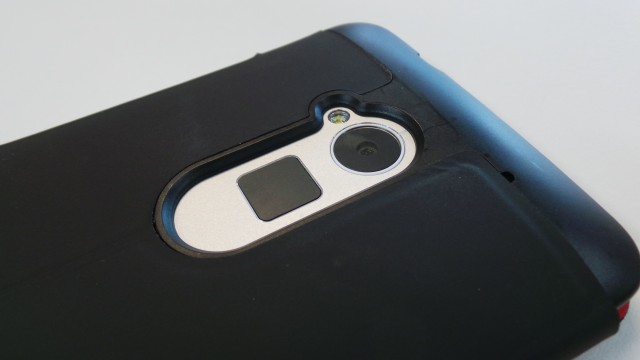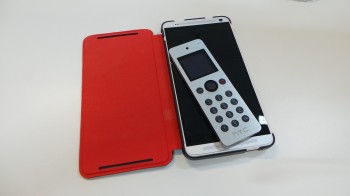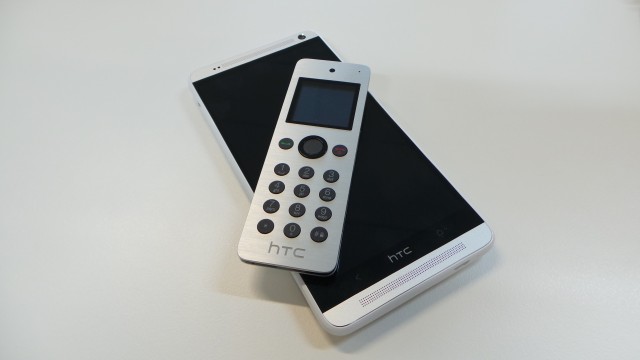
HTC launched the One‘s big brother – the One Max – today. We’ve been lucky enough to spend a bit of hands-on time with the device this afternoon.
Physically, the One Max is an imposing device. Owing to its 5.9 inch screen with physical buttons and BoomSound speakers above/below, it’s about one and a half wallets tall and has quite a heft to it. The added weight is perhaps the price of using the metal parts for which HTC’s range has been so well known this year.
The One Max borrows more from the One Mini than the One in terms of looks – it has a white plastic edge and seems to be mainly constructed from plastic with aluminium front and back, while the One was famously constructed out of a single piece of machined aluminium.
Compared to the One and One Mini, the Max’s power button has been moved to the side, where it now falls naturally under your middle finger while your index finger controls the volume buttons (whose location hasn’t changed). There is still an IR blaster in its original location at the top left of the device. Unfortunately, it still wobbles if you attempt to use it on a flat surface.
Behind the scenes, the One Max is powered by a Snapdragon 600 processor – the same processor that powered the original One. We’ve heard rumours that HTC had trouble sourcing the newer Snapdragon 800, but it’s worth remembering that the One was no slouch when it came to general use, and there’s no major change in specifications on the Max that might make the CPU work harder.

Big Screen Style
HTC’s earned a reputation for using quality screens in its flagship devices over the past couple of years, with the screens in the One X and the One particularly impressing.
The One Max doesn’t disappoint, but does seem to be calibrated with a different screen temperature compared to its progenitor. This might change as the device approaches final release.

Software Story
Overall, there don’t seem to have been any substantial changes to Sense itself, at least in terms of the actual UI skin and how it looks and functions. Android 4.3 is now running the hood although, as we’ve seen with other manufacturers, you’d be hard pressed to tell the difference.
The Beats Audio toggle appears to have been removed from the settings screen – notably, the brand has also been removed from the back of the device despite earlier assurances that it would be present. Without any extra time, it’s hard to determine whether the quality of the audio output will suffer, or if the BoomSound magic really is all in the hardware.
Digging around the software on offer, we find a couple of interesting roadblocks. Both the Android Version and HTC Sense Version both say “Protected” – perhaps a hint that the software might not be final.
Space Inside
The back cover is held in place with a kind of spring-release mechanism, which ends up feeling like a hinge when the switch is pressed. The switch itself is on the top-left of the device and is almost flush with the body. It requires a conscious effort to flip it, so it’s very unlikely you’ll do so by accident.
Once removed from the device, the back cover itself is surprisingly solid, but it does bend, so you’d best not push it too hard.
HTC’s listened to criticisms of the One, and made good on its word that it really couldn’t fit a Micro SD slot. The One Max supports MicroSD cards up to 64 GB, but both the SD card and the SIM card are inside the device.
It seems a bit of a waste to remove the back cover to access just the SD card and SIM slots, especially when you can’t access the battery. The Max has space to spare for slots like this along its edges, although HTC has avoided putting anything important on the left of the device – perhaps a concession for when the device is inside a flip cover.
Fingerprint Scanner

One of the additions to the One Max’s hardware that’s garnering a lot of attention – likely in the wake of another high profile manufacturer’s addition of it to their prodct – is the fingerprint scanner, located below the camera on the back of the device.
The addition of controls on the back of a device seems to be a controversial choice. LG made a similar bet on rear controls this year, with the G2‘s volume buttons. It seems an odd place to put a fingerprint scanner though, because rather than searching for a tactile control button you need to be more conscious of precisely which finger you’re putting where.
The One Max can store up to 3 fingerprints (there’s no way around it, that number is an odd choice). You can configure actions per-fingerprint. For example, your right index finger might unlock the device while your left could launch the camera.
How well does it work? Well, it does OK. There’s a slight delay between scanning a fingerprint and verifying that it’s correct. In about 30 scan attempts I’d say 25 were successful, and a couple of the misses were probably my own fault. It might be easier if I could see it, though.
When you add your first fingerprint, it seems to become your unlock security setting. Using a fingerprint to unlock the screen leads to somewhat odd unlock behaviour – you have to power the screen on, swipe the unlock icon up, then scan your fingerprint.
Accessorise My Max
The One Max I played with today had two accessories delivered along with it – the battery cover, and the mini bluetooth handset. Together, they transform the One Max:

If you’ve been concerned about the battery life of your phone, the battery cover adds 1150 mAh of battery power to the device’s already generous 3300 mAh, and does it without adding much heft to the device. The cover connects to the pogo pins on the back of the device. When connected, a + appears next to the battery display to indicate that’s it’s using the additional battery power.
The cover can be flipped open, and bend back on itself as a stand. While this sounds useful, the stand is actually a little disappointing because there’s nothing to actually keep it standing up, so it falls over a lot unless you find a way to anchor it. Blu Tack helps.
It seems likely that third parties will make their own interpretations of this cover which might do better with the concept, although we’ve seen devices with pogo pins on them before that the accessory market has all but abandoned. Hopefully now that HTC’s shown the way we’ll see some adoption of this feature.
HTC’s mini bluetooth handset is both adorable, and ridiculous. Fortunately, adorable wins. The device can function purely as a bluetooth device to make and receive calls (and can pair with other phones) but when you connect it to a One Max it also works as a remote control, reading the configuration from the One Max, and displays messages and browses your calls list. It almost seems as if HTC’s nailed the smartwatch use case, and now just needs to build a watch to contain the functionality…
That’s all well and good, but it’s also a concession to the fact that the device is really quite heavy, and therein lies the ridiculous aspect. In order to combat a massive, heavy phone, HTC’s paired the One Max with … a smaller phone.
It’s early days yet for the device, and details of the proper local release are yet to be finalised although Optus has tipped its hand early. We’re anxious to give it the full Ausdroid review treatment and we’re hoping we’ll get a chance to do so in the coming weeks.
We’d like to thank Trevor Long for our hands-on time with the device. If this has given you an appetite for more on the One Max, be sure to check out Trevor’s review at EFTM.
Are you interested in the One Max? Let us know in the comments!




